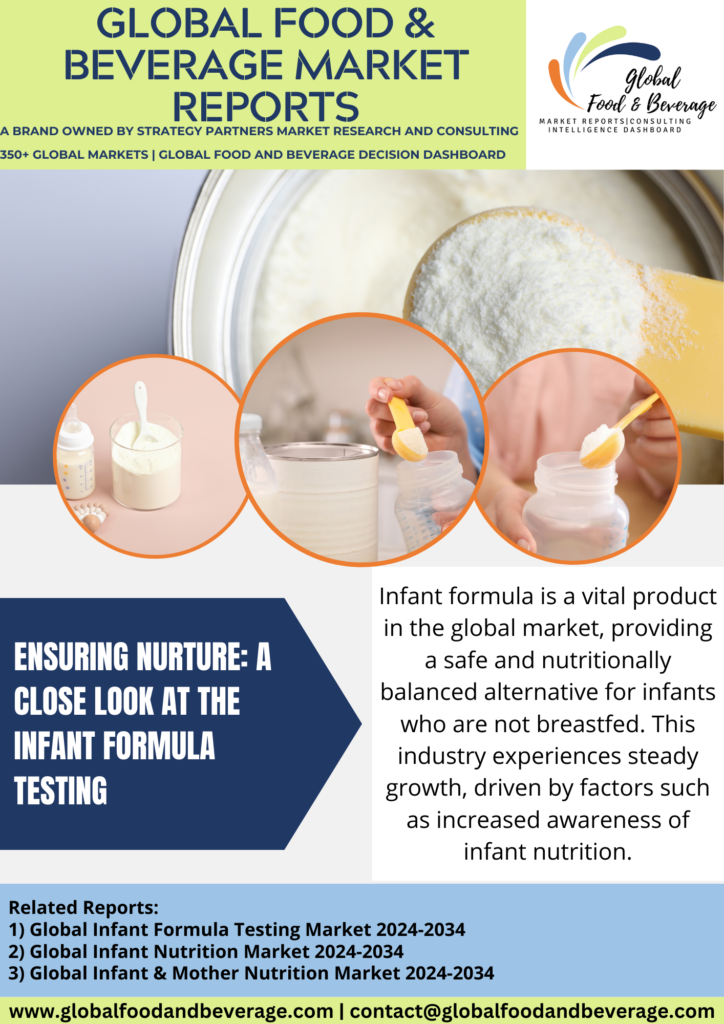Ensuring Nurture: A Close Look at the Infant Formula Testing Market Trends

Infant formula testing is a critical process that ensures the safety, quality, and nutritional adequacy of commercial infant formulas before they reach the market. These rigorous tests are conducted to comply with stringent regulatory standards and to provide parents with the assurance that the formula is a reliable alternative when breastfeeding is not feasible.
One of the primary aspects of infant formula testing involves nutritional analysis. Laboratories assess the levels of essential nutrients, such as proteins, fats, carbohydrates, vitamins, and minerals, to ensure that the formula aligns with established guidelines for infant nutrition. Accurate nutritional content is vital for supporting the healthy growth and development of infants who rely on formula as their primary source of nourishment.
Microbiological testing is another crucial component, focusing on the absence of harmful bacteria, molds, and other contaminants that could pose health risks to infants with developing immune systems. Strict hygiene standards and the prevention of microbial contamination are paramount to guarantee the safety of the product.
Contaminant testing involves screening for any potential harmful substances, such as pesticides, heavy metals, and mycotoxins, that might find their way into the formula during the production process. This meticulous examination ensures that the infant formula is free from harmful substances that could compromise the health of vulnerable infants.
Sensory analysis is conducted to evaluate the formula’s taste, smell, and overall palatability. This aspect is crucial, as it directly influences an infant’s acceptance of the formula, especially during the transition from breast milk. Formulas with pleasant sensory attributes are more likely to be well-received by infants, facilitating easier feeding practices.
Furthermore, quality control measures encompass aspects like stability and shelf-life testing to assess the formula’s durability and effectiveness over time. These evaluations ensure that the formula remains nutritionally sound and safe for consumption throughout its designated period of use.
ADVANCEMENTS
Infant formula testing contribute to ensuring the safety, nutritional quality, and compliance of these essential products for infant nutrition. One significant breakthrough is the application of advanced analytical techniques for quality control. High-performance liquid chromatography (HPLC), mass spectrometry, and nuclear magnetic resonance (NMR) spectroscopy are increasingly employed to precisely quantify and characterize the nutritional components of infant formulas, including proteins, fats, carbohydrates, and micronutrients.
The development of targeted testing methods for contaminants and adulterants is a critical advancement. Rigorous testing protocols now include screening for contaminants such as heavy metals, pesticides, mycotoxins, and microbiological hazards to ensure that infant formulas meet stringent safety standards. DNA-based techniques are also employed to verify the authenticity of ingredients and detect any potential adulteration.
Advancements in allergen testing contribute to the identification and quantification of allergenic proteins in infant formulas. Improved methods, such as enzyme-linked immunosorbent assays (ELISA) and polymerase chain reaction (PCR), help ensure that allergens, such as cow’s milk proteins or soy proteins, are within acceptable limits to minimize the risk of allergic reactions in infants.
The use of near-infrared spectroscopy (NIRS) allows for rapid and non-destructive analysis of infant formula composition. This technology enables manufacturers to quickly assess the nutritional content of raw materials and finished products, streamlining quality control processes.
In response to increased awareness of the importance of the microbiome in infant health, advancements in microbial testing methods are applied. Molecular techniques, including next-generation sequencing, provide insights into the microbial composition of infant formulas, ensuring the absence of harmful pathogens and promoting the presence of beneficial microorganisms.
Overall, these advancements in infant formula testing reflect a commitment to precision, safety, and quality in the production of these crucial products, providing reassurance to parents and healthcare professionals about the nutritional integrity of infant formulas.
CHALLENGES
Infant formula testing faces challenges across various dimensions, including safety, quality control, regulatory compliance, and consumer trust. One significant challenge is ensuring the safety of infant formula products. Rigorous testing for contaminants, such as heavy metals, pesticides, and microbial pathogens, is essential to meet strict safety standards and ensure that the final product is free from harmful substances.
Quality control throughout the production process poses ongoing challenges. Maintaining consistency in nutritional content, texture, and flavor across batches demands precision in formulation and manufacturing processes. Stringent quality assurance measures are necessary to meet regulatory requirements and provide infants with a reliable and standardized nutritional source.
Regulatory compliance is a complex challenge in the infant formula industry. Adhering to diverse and evolving regulations related to labeling, health claims, and safety standards requires continuous diligence to ensure transparency and compliance with global standards.
Market competition in the infant formula industry is intense, with various products available. Successfully differentiating products, addressing diverse nutritional needs, and staying competitive demand continuous innovation in formulations, packaging, and marketing strategies.
Addressing concerns related to authenticity and counterfeiting is an emerging challenge. Ensuring the traceability and authenticity of ingredients and final products is crucial for preventing fraudulent practices and maintaining consumer trust.
Consumer education is vital for promoting confidence in infant formula products. Effectively communicating the safety measures, nutritional benefits, and adherence to regulatory standards is essential for building awareness and trust among parents and caregivers.
CONCLUSION
Infant formula testing epitomizes a stringent commitment to ensuring the safety, quality, and nutritional integrity of a crucial early-life nourishment source. As scientific advancements and regulatory standards evolve, the industry’s dedication to thorough testing protocols safeguards the well-being of the most vulnerable consumers. The meticulous scrutiny of ingredients, contaminants, and nutritional composition reflects a proactive approach to infant health. The future holds a promise of continuous innovation in testing methodologies, addressing emerging concerns, and enhancing transparency. In this pivotal role in early childhood nutrition, infant formula testing remains an essential guardian, contributing to the assurance of a healthy start for infants worldwide.
